Alan Cathcart | March 9, 2019
2019 Royal Enfield INT 650 & Continental GT 650 Review
One of the world’s most glorious motorcycle manufacturers is back with a bang in the U.S., and we took Royal Enfield’s two new bikes—the 2019 Royal Enfield INT 650 and Continental GT 650—for a spin to see what all the fuss is about.
 Two peas in a pod. The INT 650 (left) and the GT (right) signal a new horizon for Royal Enfield.
Two peas in a pod. The INT 650 (left) and the GT (right) signal a new horizon for Royal Enfield.
After more than 50 years of manufacturing its 350-550cc Bullet singles in Chennai, India, Royal Enfield has finally produced its long-awaited first-ever parallel-twins.
The overhead-cam 650cc Continental GT and Interceptor (known in the U.S. as the INT 650, since Honda owns the rights to the Interceptor name) are finally heading for dealerships around the world, starting with here in the USA.
With deliveries now commencing to the 90-plus dealers in what RE’s dynamic CEO Siddhartha Lal forecasts will become its largest export market, the selection of eye-catching retro paintwork choices available across the Standard, Custom and Chrome versions are available here for bargain basement prices.
These start at $5799 for the INT 650 roadster, and $5999 for the equivalent Continental GT café racer models, and up to $6749 for the top-of-the-range versions. That’s a lot of motorcycle for the money—but even better, those keen prices include a three-year unlimited mileage warranty and roadside assistance.
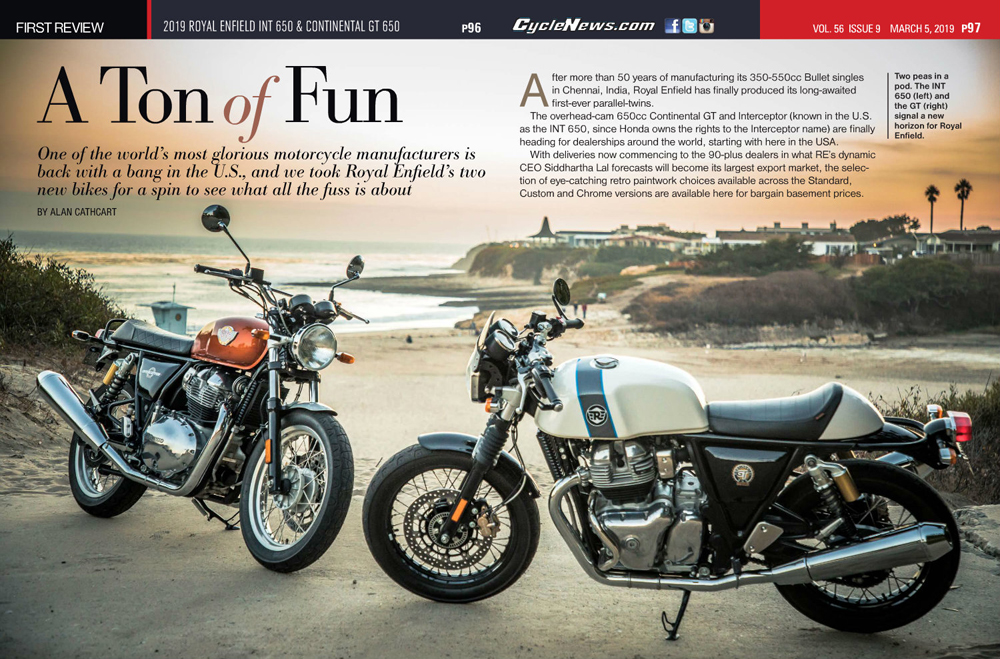
The Indian manufacturer chose the surfing town of Santa Cruz on the Central California Coast for the global riding launch of these two bikes—the first twin-cylinder volume production motorcycles ever built in India, and the country’s first-ever ton-up street bikes capable of traveling at over 100 mph.
California’s post-war biking boom created a revolution in British motorcycle manufacturing, and helped Royal Enfield establish itself as a global brand. Now Lal is hoping to do it over again with these two models powered by the company’s all-new 648cc air/oil cooled parallel-twin motor with 270° crank, jointly developed in India and at the company’s state-of-the-art British technology center at Bruntingthorpe.
Despite being “just” a 650, it’s a visually imposing motor, which fills the frame, with its polished engine covers matching the double-skinned chrome exhaust. It’s worth noting that Enfield’s performance partners S&S have already produced an 865cc version of the engine for the Lock Stock factory custom, without any modification to the external engine castings. Word is that there are two further new Royal Enfield twin-cylinder platforms being launched in the next five years, each with a different chassis and different engine capacity as part of a 12-model blitz that Lal intends should establish his company as the global leader in the middleweight motorcycle market.
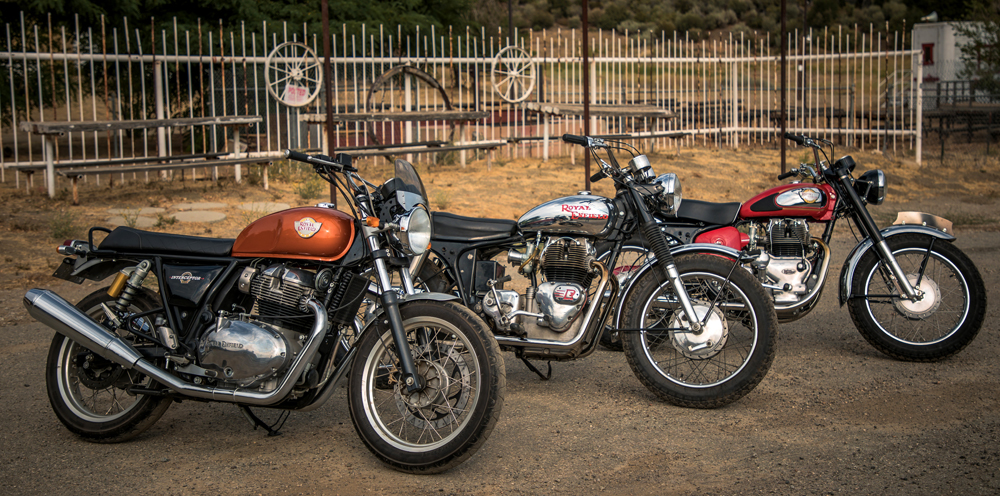 Old and new: The INT 650 versus the OG singles from Royal Enfield that powered India for generations.
Old and new: The INT 650 versus the OG singles from Royal Enfield that powered India for generations.
But that’s in the future and the INT 650 and Continental GT are here right now, and a close look at the new bikes during two full days of riding them through the spectacular mountain roads around Santa Cruz revealed that Royal Enfield’s build quality has taken a significant step forward.
Great attention to detail is evident, and while the switch blocks can’t help looking rather bland without any electronics other than EFI and ABS on a bike with a cable throttle, hence devoid of ride-by-wire technology, they look well made and substantial. The classic-style twin-clock analog instruments feature a separate tacho and speedo, with a small LCD screen displaying fuel level, odometer and two trips, but no clock or gear indicator.
We had entire successive days aboard each model, with ample time to evaluate each thoroughly.
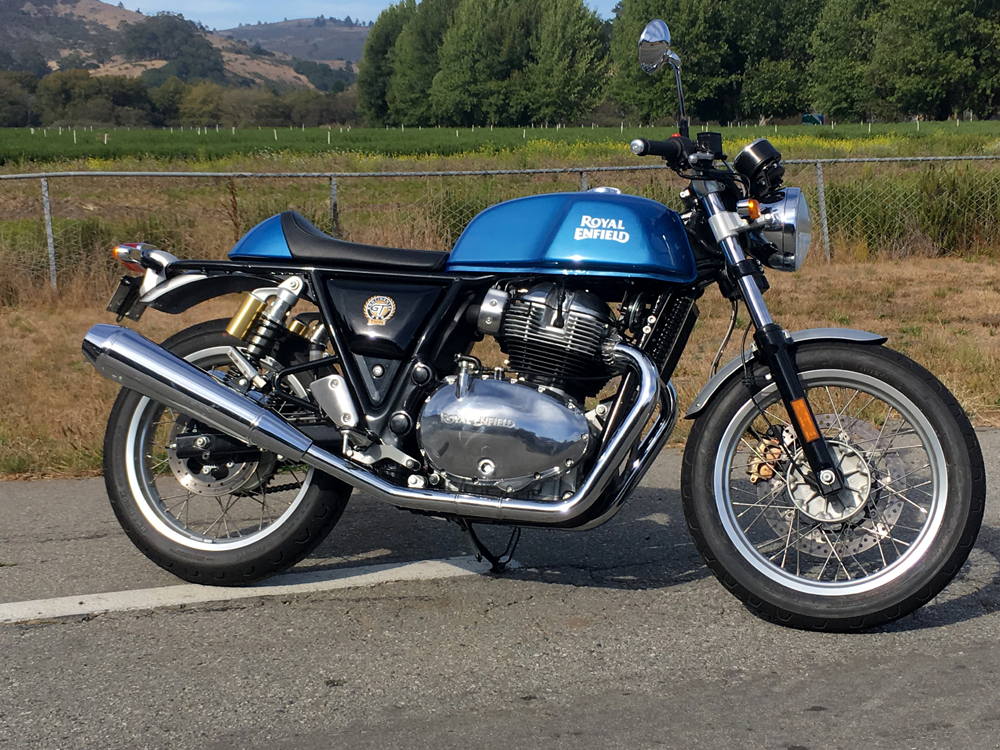 The GT is an integral part of the mind-blowing 850,000 motorcycles that get sold from Royal Enfield.
The GT is an integral part of the mind-blowing 850,000 motorcycles that get sold from Royal Enfield.
2019 Royal Enfield Continental GT 650
First up was the single-seat Continental GT, and climbing aboard revealed a lengthy reach to the clip-on handlebars, delivering a sporty, hunkered-down stance on the move. The slim seat format where it meets the fuel tank and its 31.2-inch height allowed an easy reach to the ground, and my 5’10” frame found the seating position pretty comfortable, with knees tucked snugly into the gas-tank cutouts. There’s no undue weight on your arms and shoulders, and I felt far from tired after a 150-mile day of spirited riding, just exhilarated.
The twin-cylinder engine identical to both models is definitely the star of the show in terms of riding satisfaction on these new Royal Enfields, for this is a little bike—okay, a middleweight—that thinks big.
It’s been cleverly developed to be all things to all riders, so that newbies and the less experienced can ride around town all day in sixth gear if they want, and the hyper-flexible engine will let them do so with zero hiccups or transmission snatch.
But at the other end of the performance scale, it’s a willing companion for a high-speed blast through the winding roads of the Californian Redwood forests to Skyline Boulevard, and the legendary Alice’s Restaurant. You’ll never forget it’s just a 650, because it doesn’t have the torque or power of a 900cc twin or even a 750—but that’s completely okay, because the Royal Enfield motor invites you to work hard at making it go fast—as it will. Just make maximum use of the light action slip-assist clutch and precise, if slightly notchy, gearshift (perhaps because the bikes were all so new, straight off the 3000-unit pre-production line) to keep it revving, and you’ll be rewarded with impressive levels of performance from the 78 x 67.8mm SOHC motor if you kick it down two or three gears at a time, to get the engine working harder. It’s a willing partner in making both new Royal Enfield Twins a ton of fun to ride hard.
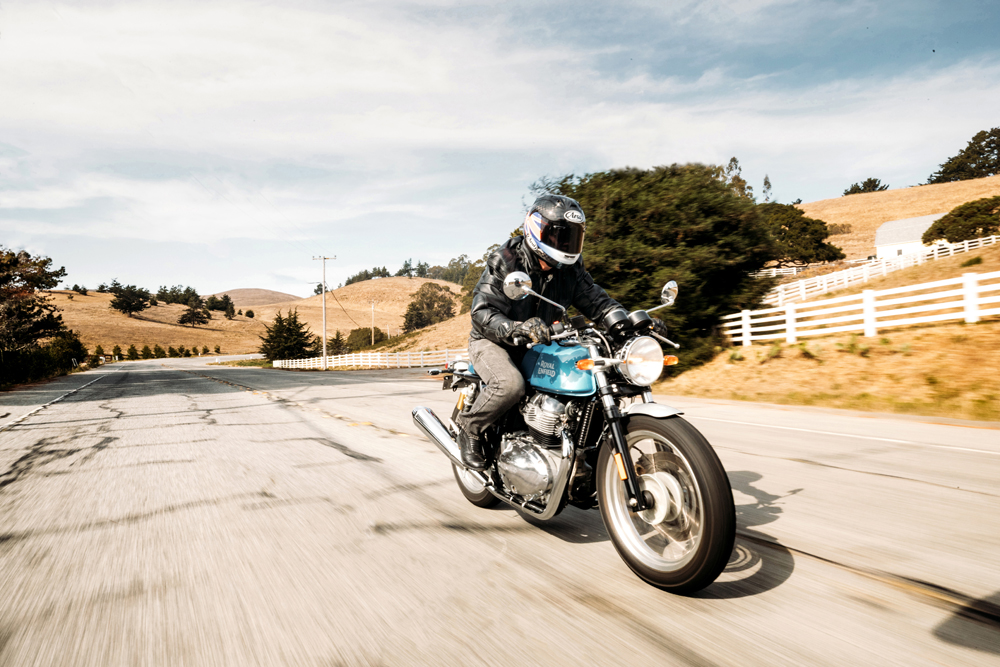 Hook in on the GT and you’ll get a surprisingly large amount of performance for such an inexpensive machine.
Hook in on the GT and you’ll get a surprisingly large amount of performance for such an inexpensive machine.
The engine’s number one asset is the flawless mapping of the Bosch ECU achieved by RE’s ex-Keihin computer mastermind Takashi Yamamoto and his team. It’d be impossible to improve on the fueling and especially the pickup from a closed throttle, which is ultra-smooth and devoid of even the slightest jerk. That’s especially so after braking deep into a turn, then getting back on the gas to drive hard out—there’s a liquid-smooth but still immediate response from closed to part-open throttle that’s literally perfect. Again, it’s an ideal ride for the less experienced—you just twist and go, with a totally linear build of both power and torque, peaking at 7250 rpm with 47 bhp on tap, and 38 lbs-ft of torque at 5250 rpm. From throttle opening through to the 7500 rpm rev-limiter, the power delivery is quite impressive for a middleweight motor, with its abundant torque ideally spread throughout the rev range.
The single gear-driven counterbalancer removes every trace of vibration all the way to the hard-action 7500 rpm limiter, which, to start with, I frequently made friends with because the torque curve is so completely flat that you have no advance warning you’re nearing peak revs by the way the torque tails off. The sound from the stock exhaust is an enjoyable, semi-angry burble, that’s inevitably similar to a 90° V-twin thanks to the 270° crank, although the throaty sound of the aftermarket (but still Euro-4 compliant) S&S slip-ons that one of the bikes was carrying, will surely make them a must-have item for many who hear them.
 Classic looking, but the Enfield Twin has been developed from the ground up for these two machines.
Classic looking, but the Enfield Twin has been developed from the ground up for these two machines.
Though it doesn’t get tiring, the Continental GT’s riding position places lots of the rider’s weight on the handlebar, providing good feedback from the front Pirelli tire even though the well-damped Indian-made Gabriel 41mm conventional-style fork, with 110mm of travel, is non-adjustable.
These new 650 twins may be built to a price point, but Royal Enfield’s engineering team has achieved much with its brief. At a relaxed pace, the fork absorbs bumps in the road surface easily, though the more heavily sprung twin-shock rear end, with its limited 88mm of wheel travel, does skip about over bumps, plus ride quality isn’t the greatest over rippled everyday road surfaces. The stiffly sprung shocks’ insufficient rebound damping caused the bike to bounce around over some bumps, but despite that short stroke length there was no bottoming out.
But that minor suspension gripe is compensated for by the well-designed frame courtesy of RE subsidiary Harris Performance, that’s stiff and predictable. At speeds possibly a little above the speed limit, the Enfield Twins handled fast changes of direction capably through successive flowing S-bends taken in third or fourth gear. This further demonstrated the success of the development work that’s gone into making the chassis handle so well on its 18-inch wheels shod with retro-look Pirelli Phantom Sportcomp tires specially developed by the Italo-Chinese company for these two models.
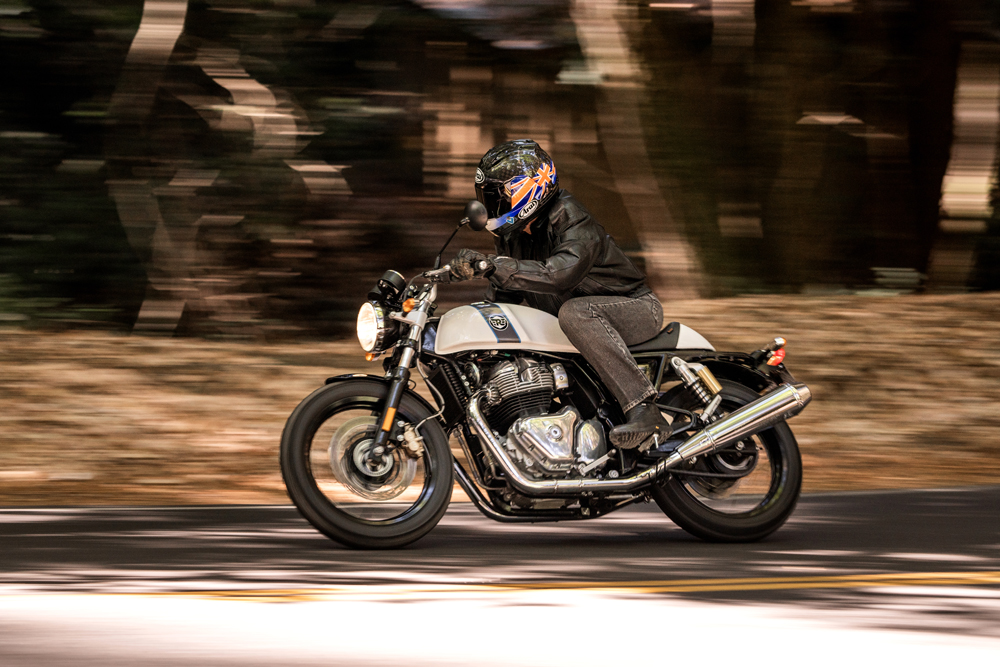 Is Royal Enfield looking at going flat-track racing with the Continental GT? Never say never.
Is Royal Enfield looking at going flat-track racing with the Continental GT? Never say never.
These went a long way towards delivering the easy and fun-riding nature of the Indian-built Twins that’ll make them an enjoyable and confidence-inspiring ride for RE’s target audience of new riders stepping up from a single, or more experienced ones looking for a fun-filled middleweight ride. The compacted mass of the parallel-twin engine package compared to a rangier V-twin motor also helps it turn more easily, and the relatively sharp steering geometry with a 24° head angle and 106mm of trail, coupled with a relatively tight 1400mm wheelbase, all combine to make it steer well.
Brembo’s Indian affiliate Bybre supplies the brakes, and the front single 320mm disc and twin-pot caliper stop okay, with nice feedback through the lever, but could benefit from more initial bite. Probably pad choice is directed towards not making less experienced riders feel nervous about locking the brakes (they won’t, with ABS fitted as standard), but you must use both brakes hard to stop from any speed. At the rear, the single-pot caliper and 240mm disc are good for settling the bike mid-corner, but the rear ABS was a little hit and miss, allowing the rear tire to momentarily lock on occasion when the brake pedal was worked hard.
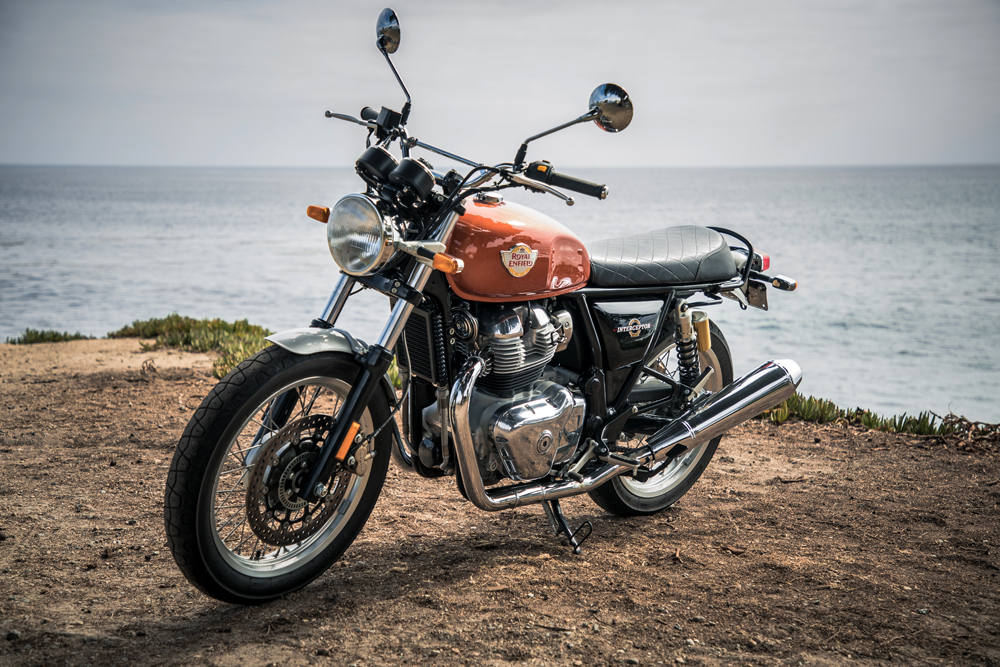 Enfield is not aiming the INT 650 at just new riders, hoping to provide a solid machine for any caliber of pilot.
Enfield is not aiming the INT 650 at just new riders, hoping to provide a solid machine for any caliber of pilot.
2019 Royal Enfield INT 650
Following a Bollywood-style beachside presentation the previous night, a second day of coastline cruising on the INT 650 was the perfect morning-after wake-up call—especially with Sid Lal riding alongside for 50 miles or so! How many other CEO’s of a multi-billion dollar manufacturer would turn out after a seriously good party the night before to ride one of his products with a bunch of journalists? It says much about the man in charge and his vision for the company, as well as the fact that he simply loves riding bikes. I wish there were more like him.
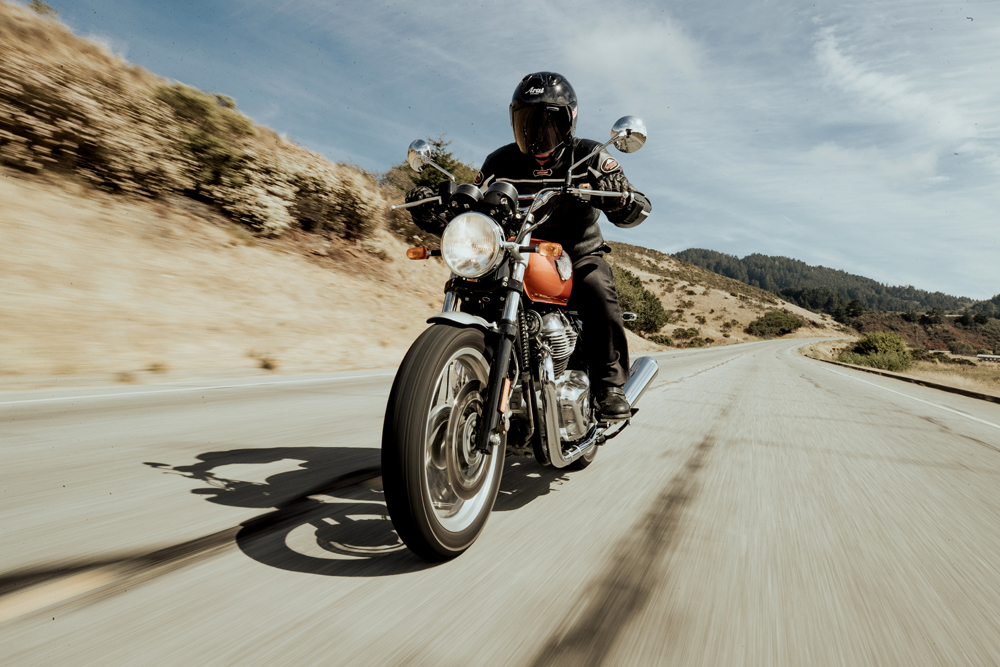 No 800-900cc twins just yet, but you don’t really need it with the INT 650. It’s a pleasure to ride.
No 800-900cc twins just yet, but you don’t really need it with the INT 650. It’s a pleasure to ride.
You’d think just swapping the seat, tank and handlebar on a motorcycle wouldn’t much change how it feels to ride, but the Continental GT and INT 650 have totally different personalities. The longer, taller (31.6 inches) and better padded seat on the INT 650 provided greater comfort than the GT, especially with the footpegs brought 2.5 inches further forward. The extra space to move about on this bike makes it feel longer and more spacious than the GT, even though the pulled-back handlebar delivers a taller, more upright stance. Cruising gently along the coast road in Santa Cruz on the INT 650 past the surfers making their way to the beach to catch an early morning wave, it felt like a capable everyday ride.
However, another enjoyable blast through the Redwood forests’ twists and turns revealed that the INT 650 liked to push the front wheel more than the Continental GT, so I kept missing apexes and had to back off the throttle to pull it back on line. At one of our stops I talked this over with ex-500 GP racer Paul Young, Royal Enfield’s chief test rider who’s been responsible for refining the bikes’ handling so well. He delivered the fix straight away, adding two turns to the preload adjusters on the Gabriel shocks, which raised the rear ride height 8mm for more weight on the front wheel (stock as delivered sees a 48/52 rearward bias on the INT 650, 50/50 on the GT), and tightened the fork’s effective head angle. Enfield delivers the INT 650 this way to give a more compliant ride with greater wheel travel to cope with bumps and dips in the tarmac in urban use, but for more spirited riding, it needs a bit of adjustment. But the Gabriel fork was as well behaved as ever, with unchanged damping from the GT.
 The INT 650 provides a more relaxed ride than the Continental, with weight distribution set at 50/50 front to rear.
The INT 650 provides a more relaxed ride than the Continental, with weight distribution set at 50/50 front to rear.
Both these new Royal Enfield Twins are enjoyable mid-capacity retro-styled bikes blessed with a great engine, and superb handling. And when their low price point is taken into consideration, then very likely Sid Lal will have the hit on his hands he’s hoping for. For there’s indeed nothing else in the market remotely like these 650cc Twins, and certainly nothing else giving comparable performance for such a low price—for the time being.
But on the other side of India in Pune, Mahindra today is busy developing its future range of BSA models which will apparently be along the same lines as these new Indian-made twins. The Royal Enfield Continental GT and INT 650 are already here, not some way down the road—and are built by a company with an impressive track record of delivering increasingly well made products at a good price. Until now, they only built singles. Can RE make the big step upwards to make twins that people want to buy, too? Based on my two days’ ride along the Central California coast, the answer must be—yes. CN
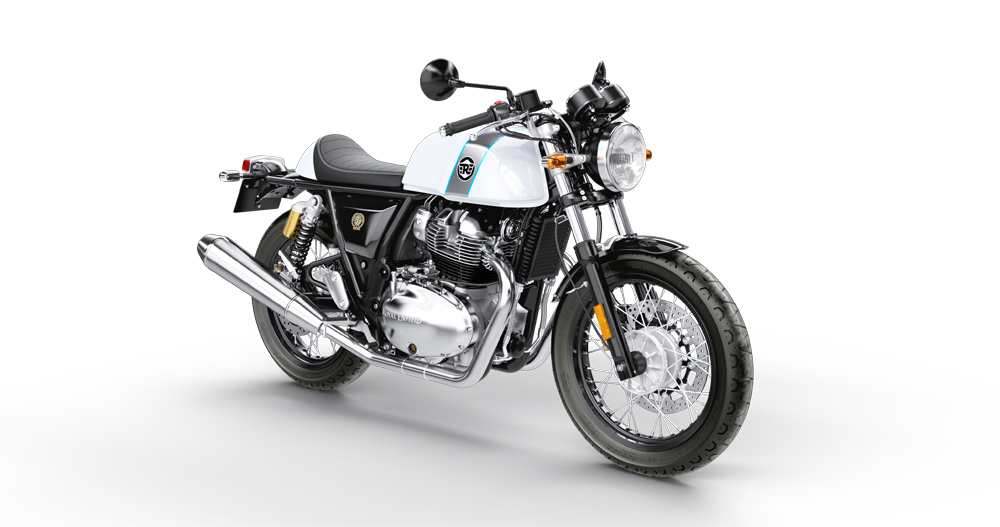
Royal Enfield INT 650 / Continental GT 650 Specifications
| MSRP: |
$5799 / $5999-$6749 |
| Engine: |
Air/oil-cooled 4-stroke, 8-valve, SOHC, dry-sump, parallel-twin |
| Bore x Stroke: |
78 x 67.8mm |
| Displacement: |
648cc |
| Horsepower: |
47 bhp @ 7250 rpm (at crankshaft) |
| Maximum torque: |
52 Nm at 5250 rpm (at crankshaft) |
| Compression ratio: |
9.5:1 |
| Fuel system: |
Multipoint sequential Bosch EFI w/2 x throttle bodies |
| Ignition: |
Digital spark ignition, DCI |
| Transmission: |
6-speed w/gear primary drive |
| Clutch: |
Multiplate oil-bath slip-assist |
| Chassis: |
Tubular steel duplex cradle frame |
| Front Suspension: |
41mm Gabriel telescopic fork |
| Rear Suspension: |
Box-section steel swingarm with 2 x Gabriel coil-over gas-charged piggyback shocks, with 5-stage preload adjustment |
| Front wheel travel: |
4.3 in |
| Rear wheel travel: |
3.5 in. |
| Rake/Trail: |
24°/4.2 in. |
| Wheelbase: |
55.1 in. |
| Weight (dry): |
445.3 / 436.5 lbs. |
| Front Brake: |
Single 320mm steel disc w/2-piston caliper; Bosch ABS |
| Rear Brake: |
Single 240 mm steel disc w/2-piston caliper; Bosch ABS |
| Front Wheel/Tire: |
100/90-18 in., 2.50 in. wire-spoked wheel / Pirelli Phantom Sportcomp |
| Rear Wheel/Tire: |
130/70-18, 3.50 in. wire-spoked wheel / Pirelli Phantom Sportcomp |
| Seat Height: |
31.7 / 31.1 in. |
| Fuel Capacity: |
3.6 / 3.3 gal. |